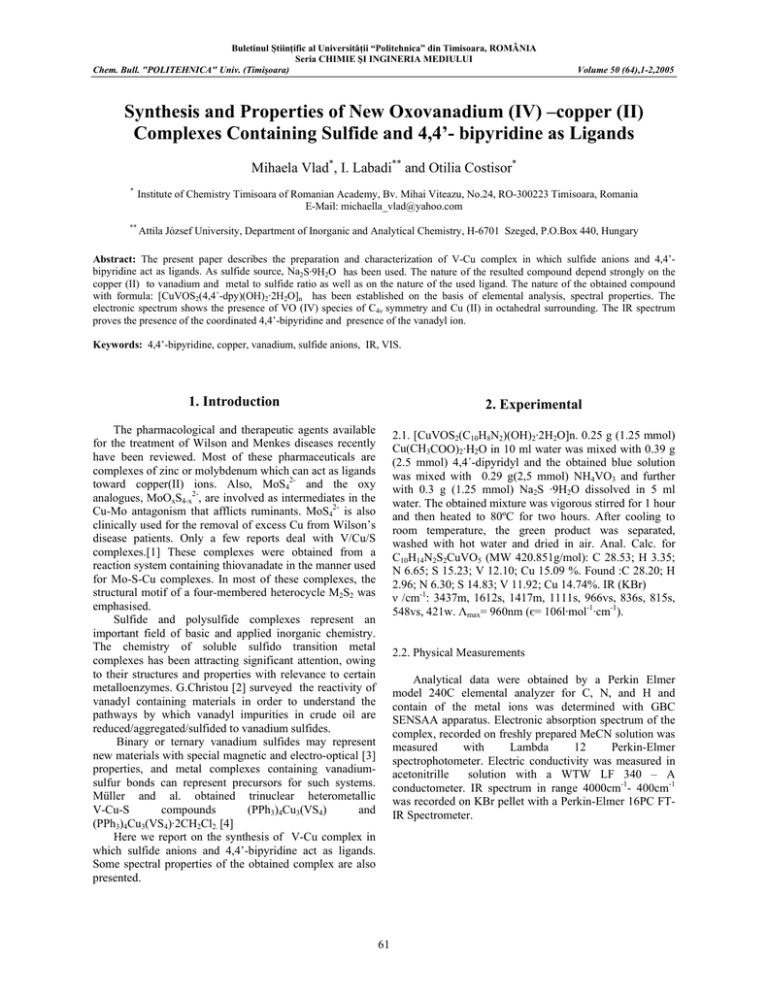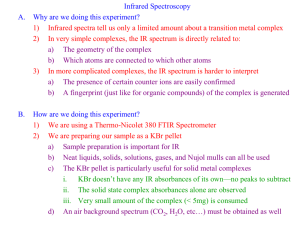Document 13359580
advertisement

Buletinul Ştiinţific al Universităţii “Politehnica” din Timisoara, ROMÂNIA Seria CHIMIE ŞI INGINERIA MEDIULUI Chem. Bull. "POLITEHNICA" Univ. (Timişoara) Volume 50 (64),1-2,2005 Synthesis and Properties of New Oxovanadium (IV) –copper (II) Complexes Containing Sulfide and 4,4’- bipyridine as Ligands Mihaela Vlad*, I. Labadi** and Otilia Costisor* * Institute of Chemistry Timisoara of Romanian Academy, Bv. Mihai Viteazu, No.24, RO-300223 Timisoara, Romania E-Mail: michaella_vlad@yahoo.com ** Attila József University, Department of Inorganic and Analytical Chemistry, H-6701 Szeged, P.O.Box 440, Hungary Abstract: The present paper describes the preparation and characterization of V-Cu complex in which sulfide anions and 4,4’bipyridine act as ligands. As sulfide source, Na2S·9H2O has been used. The nature of the resulted compound depend strongly on the copper (II) to vanadium and metal to sulfide ratio as well as on the nature of the used ligand. The nature of the obtained compound with formula: [CuVOS2(4,4´-dpy)(OH)2·2H2O]n has been established on the basis of elemental analysis, spectral properties. The electronic spectrum shows the presence of VO (IV) species of C4ν symmetry and Cu (II) in octahedral surrounding. The IR spectrum proves the presence of the coordinated 4,4’-bipyridine and presence of the vanadyl ion. Keywords: 4,4’-bipyridine, copper, vanadium, sulfide anions, IR, VIS. 1. Introduction 2. Experimental The pharmacological and therapeutic agents available for the treatment of Wilson and Menkes diseases recently have been reviewed. Most of these pharmaceuticals are complexes of zinc or molybdenum which can act as ligands toward copper(II) ions. Also, MoS42- and the oxy analogues, MoOxS4-x2-, are involved as intermediates in the Cu-Mo antagonism that afflicts ruminants. MoS42- is also clinically used for the removal of excess Cu from Wilson’s disease patients. Only a few reports deal with V/Cu/S complexes.[1] These complexes were obtained from a reaction system containing thiovanadate in the manner used for Mo-S-Cu complexes. In most of these complexes, the structural motif of a four-membered heterocycle M2S2 was emphasised. Sulfide and polysulfide complexes represent an important field of basic and applied inorganic chemistry. The chemistry of soluble sulfido transition metal complexes has been attracting significant attention, owing to their structures and properties with relevance to certain metalloenzymes. G.Christou [2] surveyed the reactivity of vanadyl containing materials in order to understand the pathways by which vanadyl impurities in crude oil are reduced/aggregated/sulfided to vanadium sulfides. Binary or ternary vanadium sulfides may represent new materials with special magnetic and electro-optical [3] properties, and metal complexes containing vanadiumsulfur bonds can represent precursors for such systems. Müller and al. obtained trinuclear heterometallic V-Cu-S compounds (PPh3)4Cu3(VS4) and (PPh3)4Cu3(VS4)·2CH2Cl2. [4] Here we report on the synthesis of V-Cu complex in which sulfide anions and 4,4’-bipyridine act as ligands. Some spectral properties of the obtained complex are also presented. 2.1. [CuVOS2(C10H8N2)(OH)2·2H2O]n. 0.25 g (1.25 mmol) Cu(CH3COO)2·H2O in 10 ml water was mixed with 0.39 g (2.5 mmol) 4,4´-dipyridyl and the obtained blue solution was mixed with 0.29 g(2,5 mmol) NH4VO3 and further with 0.3 g (1.25 mmol) Na2S ·9H2O dissolved in 5 ml water. The obtained mixture was vigorous stirred for 1 hour and then heated to 80ºC for two hours. After cooling to room temperature, the green product was separated, washed with hot water and dried in air. Anal. Calc. for C10H14N2S2CuVO5 (MW 420.851g/mol): C 28.53; H 3.35; N 6.65; S 15.23; V 12.10; Cu 15.09 %. Found :C 28.20; H 2.96; N 6.30; S 14.83; V 11.92; Cu 14.74%. IR (KBr) ν /cm-1: 3437m, 1612s, 1417m, 1111s, 966vs, 836s, 815s, 548vs, 421w. Λmax= 960nm (є= 106l·mol-1·cm-1). 2.2. Physical Measurements Analytical data were obtained by a Perkin Elmer model 240C elemental analyzer for C, N, and H and contain of the metal ions was determined with GBC SENSAA apparatus. Electronic absorption spectrum of the complex, recorded on freshly prepared MeCN solution was measured with Lambda 12 Perkin-Elmer spectrophotometer. Electric conductivity was measured in acetonitrille solution with a WTW LF 340 – A conductometer. IR spectrum in range 4000cm-1- 400cm-1 was recorded on KBr pellet with a Perkin-Elmer 16PC FTIR Spectrometer. 61 Chem. Bull. "POLITEHNICA" Univ. (Timişoara) Volume 50 (64),1-2,2005 The ν(OH) band at 3437 cm-1 shows the presence of coordinating water. IR spectrum of the free ligand is characterized, in part, by prominent bands appearing at aproximately 1596 and 1074 cm-1 due to ν(CN) stretching modes, at 1531 cm-1 due to ν(CC) and at 809 cm-1 due to δ(CH) stretching mode. Some of them are shifted as a result of the coordination: • the νs(C-N) bands in the free ligand appear at 1596 and 1074 cm-1 are shifted to higher frequencies at 1612 and 1077 cm-1 upon complexation • the νs (CC) band in the ligand appears at 1531 cm-1 and in the complex this band appears at 1536 cm-1. • the δ (CH) band in the ligand appears at 809 cm-1 and in the complex this band appear at 815 cm-1. The absence of absorption in the 2400 cm-1, region where N-H stretching is expected, shows that 4,4-dpy is not protonated. Thus, the very proeminent absorption at 966 cm-1 is characteristic for the vanadyl stretching mode ν (V=O). [8] A new band appears at 554cm-1 due to ν(S-S) stretching. 3. Results and Discussion The heterometallic complex [CuVOS2(C10H8N2) (OH)2·2H2O]n has been obtained from aqueous solution as microcrystalline powder. The stoichiometry of the product depends on the initial vanadium to copper and metal to sulfide ratio. Thus, the change of the V:S ratio was obtained sulphur of copper. The above compound has been obtained starting from vanadium to copper ratio of 1:2 and vanadium to sulfide anion of 1:2. Out of these values, mixtures of sulfides were obtained. The molecular formula of the obtained compound has been established on the basis of elemental analyses and some properties, as it results from the data below presented. The complex is insoluble in water and in common polar organic solvents (i.e. C1-C5 alcohols, acetone and chloroform), lightly soluble in dimethylformamide, dimethylsulphoside and acetonitril. The low molar conductivity value 40 ohm-1 cm2 mol-1 of compound was measured on 10-3 M MeCN solution leads to the conclusion that compound is non-electrolyte. [5] TABLE 1. Characteristic bands in the complex 3.1. Electronic absorption spectrum Ligand The electronic absorption spectrum of the compound is given in Fig. 1. In the visible region of the spectrum, a large band centerd at 959 nm and with shoulders at 950nm and at 975 nm was observed. 4,4´-dipyridyl IR spectrum of the Complex Assignment cm-1 3437 νs (H2O) 1596 1612 νs(CN) 1531 1536 ν(CC) 1074 1077 νs(C-N) 993 1014 breathing 966 νs(V=O) 809 815m δ(CH) 554 νs(S-S) ν s= very strong; m=moderate; w= weak; νasym= asymmetric and νsym=symmetric 4. Conclusion Fig. 1. VIS spectrum in MeCN of the complex. The elemental analyses data, VIZ and IR spectroscopy prove the reproducible character of the synthesis method and, at same time, the good definite nature of the new compound obtained. The copper (II) ion is a d9 system while VO2+ is a d1 system. The copper (II) ion is softer than vanadium (IV) on the basis of the Hard-Soft Acid-Base model and prefers the more sulfur donors. The vanadium (IV) center prefers nitrogen and sulfur donors to about the same degree. The electronic spectrum shows the presence of VO(IV) species of C2ν symmetry and Cu(II) in octahedral surrounding. The IR spectrum proves the presence of the coordinated 4,4’-bipyridine and presence of the vanadyl ion and presence of the sulfide anions. The model suggested by Ballhausen and Gray[6] for oxovanadium(IV) ion having C4ν symetry and that of the copper(II) ion in a distorted octahedral geometry [7] could explain these bands.In terms of Ballhausen and Gray´s molecular orbit Scheme, the п-bonding between the vanadium 3dxy, 3dyz orbitals and the oxygen 2px, 2py, orbitals in V=O bond is largely enchanced when ligand coordination.[6] 3.2. Infrared spectrum The infrared frequencies and their assignments are given in Table 1. 62 Chem. Bull. "POLITEHNICA" Univ. (Timişoara) Volume 50 (64),1-2,2005 5. W.J. Geary. Coordination Chemistry Reviews. 7, 1971, 81-122. 6. Ballhausen, C.J.; Gray, H.B. Inorg. Chem. 1(1), 1962, 111-121. 7. Lever, A.B.P. Inorganic Electronic Spectroscopy; Elsevier: Amsterdam, 1968; 357- 358. 8. Nakamoto, K. Infrared Spectra of Inorganic and Coordination Compounds; John Willey and Sons: New York, 1986; 244. References 1. Sarkar,B. Treatment of Wilson and Menkes Diseases. B. Chem. Rev. 99 (9), 1999, 2535-2544. 2. G.Christou, Polyhedron, 8, 1989, 1723. 3. I. Dance and K. Fisher, Prog. Inorg. Chem.. 33, 1994, 637. 4. A. Müller, J. Schimanski and H. Bögge, Z. Anorg. Allg. Chem. 544, 1987, 107. 63


